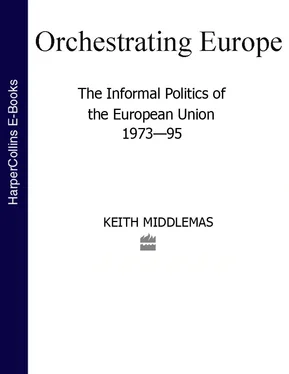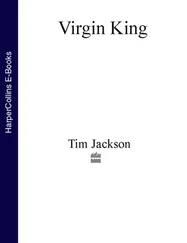At the same time, the ERM moved into its ‘classic’ phase, being transformed after March 1983 into a de facto DM zone with a core of currencies (those of Denmark, the Netherlands, Belgium and Luxembourg) linked to the DM, matched by an increasingly hard French franc. Realignments were still possible, but within progressively narrower limits, less frequently, and on principles established by the anchor country – in effect by the Bundesbank. This system served better those states which embarked on new, more market-oriented economic policies than those who tried (as France had done briefly in 1981–3) to proceed on their own. (Germany had, after all, abolished exchange controls two decades earlier.) For roughly four years, the ERM acted as an external, neutral arbiter, which suited not only governments but industrial and financial interests, because it disciplined inflation and wages and also helped to wean governments away from what these players saw as endemic overspending in pursuit of electoral support. 2
Because the British government believed it had already solved its problems, however, Margaret Thatcher saw no need to relinquish sterling’s greater margin of manoeuvre, and the more that ERM currencies converged, the less desirable entry seemed. 3Britain already had a free capital market, having abolished exchange controls in 1979, and the wild fluctuations of sterling in this period of increasingly deregulated financial markets suggested that the EMS would have little bearing on the four freedoms envisaged in the future single market; rather the reverse, for British Conservatives and many City economists expected that financial markets would force realignments, whatever governments did to prevent them. The ERM also seemed to inhibit policy flexibility towards interest rates (now the main, indeed the only monetary weapon used in London) and the supply side measures which the government believed were required to reduce labour restrictive practices and rigidities in wages. It seemed therefore that an historic cleavage inside the EC was being perpetuated, though not necessarily, as it was conceived in Britain, to the internal market’s disadvantage.
But member states aligned themselves on different axes in response to the other major feature (apart from global recovery) which encouraged ideas of regenerating the EC. Mikhail Gorbachev came to power in March 1985, after the brief Chernenko interregnum, evidently bearing a mandate from Yuri Andropov and the Soviet state institutions to reform the system from above. For France, Britain and Germany, this offered chances of playing novel roles, especially insofar as there would be trading prizes in the Comecon states. Yet at the same time the new gravitational pull eastwards imposed stresses on the Franco-German understanding. From France’s point of view, political leadership in the EC needed to be re-established to offset West Germany’s likely economic predominance in eastern Europe. Smaller member states, which had only reluctantly acceded to the French Presidency’s conduct at Fontainebleau, could be expected to take advantage of this shift in balance, and to assert themselves more in future.
In asking what each member state wanted of the internal market, and through what general framework they approached the problem of EC regeneration, it is simplest to take the largest first, according to their relative political weighting in the European Council which, growing up outside the treaties, had by now partly superseded the intergovernmental functions of the Council of Ministers.
FRANCE
Until 1981, France’s general interest had been to maintain the link with whatever government existed in West Germany, and the coherence of its worldwide policy (for example, in Africa with the Lomé II Agreement 1979), while preventing EC institutions – the directly elected Parliament and the ECJ, but above all the Commission – from acquiring power to deflect or subordinate French interests. Two years of Mitterrand’s socialist and counter-cyclical, counter-GATT programme, the first such essay since Leon Blum’s Popular Front in 1936, put in question not only the Socialist government’s economic standpoint but the nature of France’s polity and its existing relationships within the EC. After the grand tournant in 1983, however, the whole French state machine was realigned in a strongly deterministic European project, and Mitterrand assumed at Fontainebleau, as Giscard had done earlier, the role of ‘chef d’état de l’Europe’. 4
The new ‘grand project’ of integration and European Union was not immediately accepted by the Socialist party, despite the Communist ministers’ withdrawal: Jean-Pierre Chevenement and the Ceres radicals represented a powerful strand whose influence was not easily downgraded – although in the end, once the Socialist programme proved to be unrealizable, they adopted the European project with almost equal fervour. But the transformation was implemented directly from the Elysée through an increasingly well-coordinated state administration; and it received substantial backing from French industrialists, appalled at the economic consequences of the previous two years.
Its corollary, as in the 1960s, lay in modernizing French industry, banking and the economy, through the internal market and a stable exchange rate within the ERM. Mitterrand had two years in hand before the next parliamentary elections, four years before the presidential one, and he could rely on West German understanding that any attempt to break out of the ‘lourdeur des affaires communautaires’ could be successful only if France and Germany were conjoined.
In French eyes the project had four facets. Firstly, having accepted the ERM and the need for convergence, France should, if the ERM was to function properly, look beyond mere stabilization accompanied by periodic, often traumatic realignments, to a tight alignment of parities as the way to eventual Monetary Union and a single currency. 5Secondly, the social element should be enhanced but given an appropriate market-led ethos, more acceptable to West Germany and Britain than the original ‘workers’ Europe’.
Thirdly, the Parliament’s reopened debate on European Union should be assimilated – but by member states at Council level – in order to restore the EC’s institutional coherence. This ran counter to long-standing opposition to any increases in the Parliament’s competence by the Conseil d’Etat, Paris bureaucrats, and the Trésor. It even involved some support for the Spinelli initiative. Yet the problem of the indivisibility of French sovereignty, which had for years made prior acceptance of EC laws problematic, may well have been obviated by Delors’s 1985 coup de génie in putting forward simultaneously the means to satisfy both economic and political projects. Political union, which was West Germany’s major ambition, would thus become a complement to economic integration 6– in contra-distinction to the British dislike of both.
French defence policy provided a contingent element, since West Germany appeared willing at the same time to be associated with a revival of the 1963 Elysée Treaty and a renewed WEU. Geoffrey Howe’s alternative paper, put forward at Stresa, served as a further stimulus for launching the Franco-German proposed treaty on European Union in 1985, the fruit of what Simon Bulmer calls their ‘complex interdependence’, before the British initiative could acquire allies. 7Finally, having relinquished his earlier dreams of a Europe wider than the EC, Mitterrand now seemed content to see the EC as the core, to which EFTA, Mediterranean and even Comecon states could adjust. France’s role was to serve as mediator and adjudicator, a motor for scientific and technological advance, and a liberalizing influence. There was even talk of extending QMV and Commission (but not Parliamentary) competences.
Читать дальше









![Brian Thompson - A Monkey Among Crocodiles - The Life, Loves and Lawsuits of Mrs Georgina Weldon – a disastrous Victorian [Text only]](/books/704922/brian-thompson-a-monkey-among-crocodiles-the-life-thumb.webp)


